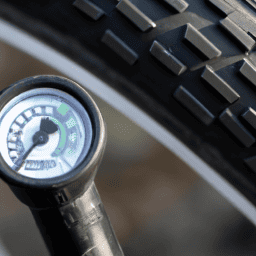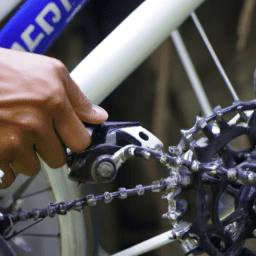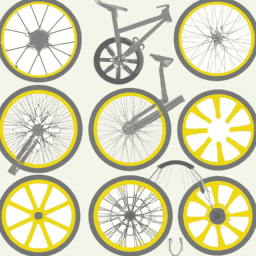Are you curious about the right amount of air to fill your bike tires with? The air pressure inside your tires can influence the smoothness of your ride, how well you can maneuver, and even your safety while cycling.
The ideal tire pressure depends on the type of tire and the weight of the rider, but with a few simple steps, you can determine the right pressure for your bike and enjoy a smooth and efficient ride.
There are different types of bike tires, including road, mountain, and hybrid tires. Each type has its own recommended pressure range, and it’s important to know which type of tire you have before inflating it.
Factors such as your weight, the terrain you’ll be riding on, and the weather conditions can also affect your tire pressure. By understanding these factors and checking your tire pressure regularly, you can ensure that your tires are properly inflated and ready for your next ride.
Key Takeaways
- Proper tire pressure affects ride quality, handling, and safety.
- Ideal tire pressure depends on tire type and rider weight.
- Recommended pressure ranges vary for different bike types and rider weights.
- Regularly checking and adjusting tire pressure improves performance and prolongs tire life.
Types of Bike Tires
If you’re not sure which type of bike tire you have, take a closer look at the tread pattern and sidewall markings.
There are two main types of bike tires: tube and tubeless. Tube tires are the traditional type of tire that uses an inner tube filled with air, while tubeless tires use a sealant to prevent air from escaping through the tire walls.
Another important consideration is whether you have road or mountain bike tires. Road bike tires are designed for smooth, paved surfaces and are thinner and smoother than mountain bike tires. Mountain bike tires, on the other hand, are thicker and have deeper treads to provide traction on rough terrain.
Knowing what type of tire you have is important for determining the appropriate air pressure. With that in mind, let’s explore the factors to consider when determining how much air to put in your bike tires.
Factors to Consider
When inflating your bike tires, it’s important to take into account various factors that can impact your ride. One of the most significant factors to consider is the type of terrain you’ll be riding on. For example, if you’ll be riding off-road, you’ll want to opt for a wider tire with a lower pressure to improve traction and reduce the risk of punctures.
On the other hand, if you’ll be riding on smooth, paved roads, you’ll want a narrower tire with a higher pressure for a faster, smoother ride. Another critical factor to consider is your weight distribution. If you’re carrying a heavy load on your bike, you’ll want to inflate your tires to a higher pressure to support the added weight.
Conversely, if you’re riding with less weight, you can reduce the pressure to improve comfort and grip. It’s also important to consider the environmental impact of your tire pressure, as underinflated tires can increase your carbon footprint by requiring more effort to ride. To ensure you’re maintaining the correct pressure, it’s recommended to invest in a tire pressure gauge.
Checking your tire pressure regularly can help improve your bike’s performance and prolong the life of your tires. Now that you understand the factors that impact tire pressure, it’s time to learn how to check your tire pressure accurately.
How to Check Your Tire Pressure
To accurately check the pressure of your bike tires, start by investing in a reliable tire pressure gauge. Using a gauge allows you to get an exact reading of the pressure in your tires, which is important for maintaining the optimal level of inflation. Estimating pressure based on how your tires feel or look can lead to under or overinflation, which can affect your bike’s performance and even cause damage to the tires.
To use a gauge, simply attach it to the valve stem on your tire and read the pressure measurement on the gauge. It’s important to note that tire pressure can vary based on temperature, so it’s best to check your tire pressure when the tires are cool. The following table shows the recommended tire pressure ranges for different types of bikes:
| Bike Type | Rider Weight | Front Tire Pressure | Rear Tire Pressure |
|---|---|---|---|
| Road | < 140 lbs | 80-100 psi | 80-100 psi |
| Road | > 140 lbs | 90-120 psi | 90-120 psi |
| Mountain | All | 30-50 psi | 35-60 psi |
| Hybrid | All | 50-70 psi | 70-90 psi |
Now that you know how to check your tire pressure, you may need to adjust it to ensure optimal performance.
Adjusting Your Tire Pressure
Adjusting your tire pressure is crucial for a smooth and safe ride, and you’ll want to make sure that you get it just right for maximum performance.
The optimal pressure for your bike tires will vary depending on the type of bike, the weight of the rider, and the riding conditions. Generally, road bikes require higher pressure than mountain bikes or cruisers.
Over inflation can cause the tire to feel hard and bouncy, which can reduce traction and make the ride uncomfortable. Under inflation can cause the tire to feel soft and sluggish, which can increase rolling resistance and make the ride more difficult.
To adjust your tire pressure, start by checking the recommended pressure range printed on the sidewall of your tire. Use a tire gauge to measure the pressure in each tire, and inflate or deflate as needed to reach the optimal pressure.
It’s important to check your tire pressure regularly, as changes in temperature and altitude can affect the pressure in your tires. By maintaining the proper tire pressure, you’ll not only improve your ride quality, but you’ll also reduce the risk of flats and increase the lifespan of your tires.
So be sure to keep your tires inflated to the proper pressure, and enjoy a safe and comfortable ride.
Regularly checking and adjusting tire pressure is essential for maintaining the safety and performance of your bike. Proper tire pressure can improve traction, reduce rolling resistance, and prevent flats.
Neglecting to check your tire pressure can lead to a flat tire, unstable handling, and other potential safety hazards. So make it a habit to check your tire pressure before every ride, and adjust as needed to ensure that your bike is always ready to roll.
Importance of Regularly Checking and Adjusting Tire Pressure
To ensure optimal performance and safety, it’s crucial that you regularly check and adjust your bicycle tire pressure.
Properly inflated tires provide benefits such as improved handling, reduced rolling resistance, and increased longevity.
On the other hand, riding with incorrect tire pressure can result in increased risk of flats, decreased control, and decreased efficiency.
So, take the time to regularly check and adjust your tire pressure to ensure a smooth and safe ride.
Benefits of Properly Inflated Tires
Maintaining properly inflated tires on your bike can make for a smoother, more efficient ride. When your tires are inflated to the correct pressure, you’ll experience less rolling resistance, which means you won’t need to expend as much energy to pedal your bike. This can improve your performance and make it easier to ride for longer periods of time without getting tired.
Additionally, properly inflated tires can reduce wear on your bike’s wheels, which can save you money in the long run by extending the life of your tires.
In addition to improving performance and reducing wear, properly inflated tires can also provide better handling and increased safety. When your tires are at the correct pressure, you’ll have better traction and be able to control your bike more effectively. This is especially important when riding in wet or slippery conditions, as underinflated tires can cause your bike to slide or skid.
By maintaining proper tire pressure, you’ll be able to ride with more confidence and reduce the risk of accidents or injuries. However, riding with incorrect tire pressure can be dangerous, as we’ll discuss in the next section.
Risks of Riding with Incorrect Tire Pressure
Now that you know the benefits of properly inflated tires, it’s important to understand the risks of riding with incorrect tire pressure.
Riding with overinflated or underinflated tires can have negative effects on both your ride and your safety.
Firstly, overinflation can cause your ride to feel harsh and uncomfortable. This is because the tire is not able to absorb impacts from the road as well as it should.
Additionally, an overinflated tire has a smaller contact patch with the road, which can affect your handling and braking.
On the other hand, underinflation can cause your tires to wear out faster and can also lead to poor handling and increased risk of a blowout.
It’s important to always check your tire pressure before riding and ensure that it is within the recommended range for your specific bike and tire.
Frequently Asked Questions
How often should I replace my bike tires?
To determine when to replace bike tires, look for signs of wear and tear like cracks or thinning tread. Budget friendly options include buying in bulk or opting for tube type tires. Regular tire maintenance tips include keeping tires inflated to the recommended pressure and avoiding overloading. Consider tubeless tires for reduced puncture risk. Different types of biking require different tire widths and treads for optimal performance.
Can I use any type of tire on my bike?
When choosing tires for your bike, consider the pros and cons of different options. Road tires offer speed, while mountain bike tires provide grip on uneven terrain. Hybrid tires provide a balance. Always choose a tire that fits your bike’s specifications.
How much air pressure is too much for my bike tires?
Oh, sure. Just pump those tires up until they burst. Or, you could focus on maximizing efficiency and proper tire maintenance by checking your bike’s recommended tire pressure and adjusting accordingly. Don’t go overboard, but don’t skimp either.
Is it necessary to use a tire pressure gauge or can I just estimate the pressure by feeling the tire?
It’s recommended to use a tire pressure gauge to accurately measure air pressure in bike tires. Estimating tire pressure by feel can be inaccurate and lead to under or over-inflation. However, tips for estimating without a gauge include checking for firmness and using visual cues.
Can under-inflated tires cause damage to my bike or affect my riding performance?
Under-inflated tires can cause excessive tire wear, reduced safety implications, and negatively affect handling and braking. It is crucial to maintain proper tire pressure to ensure optimal performance and longevity of your bike.
Conclusion
Congratulations! You now know how to properly inflate your bicycle tires. Remember, the correct tire pressure is crucial for a safe and comfortable ride.
Whether you have road bike tires, mountain bike tires, or any other type, always check the recommended pressure range listed on the tire sidewall or in the manufacturer’s manual.
Think of your bike tires as the shoes of your bike. Just as ill-fitting shoes can cause discomfort and even injury, improperly inflated tires can cause a bumpy and unstable ride. So don’t neglect the air pressure in your tires.
Make it a habit to check and adjust them regularly, and enjoy a smoother, safer ride every time you hit the road or trail. Happy cycling!









